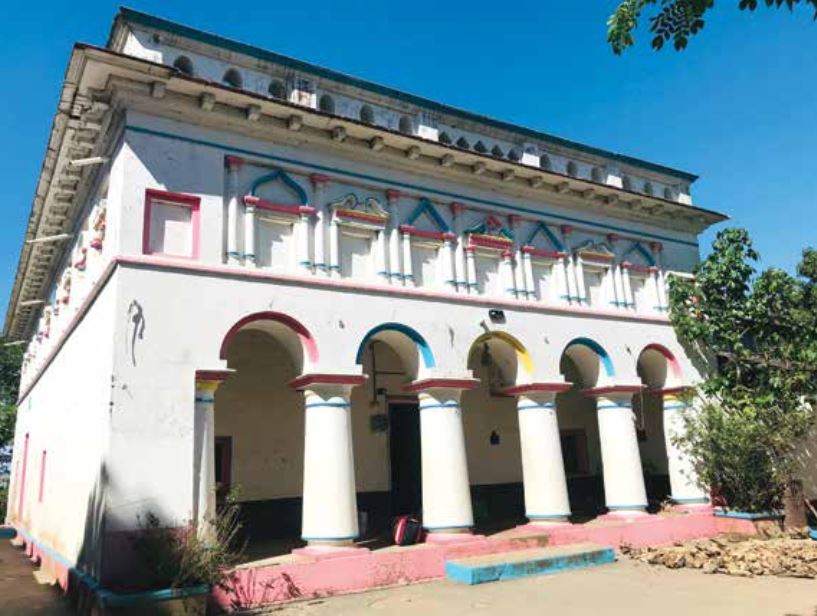Introduction-
Dhillir Akhra, located in the scenic Katkhal Union of Mithamoin Upazila, Kishoreganj, Bangladesh, is a spiritual and cultural landmark of immense historical value. Often mistaken for having connections to Delhi due to its name, Dhillir Akhra actually owes its roots to the Mughal period during Emperor Jahangir’s reign. Today, it stands as a symbol of religious devotion, community tradition, and folklore, drawing pilgrims, tourists, and history lovers alike.
This monastic and religious site serves as a powerful reminder of the spiritual and cultural synthesis that shaped the region during medieval and Mughal Bangladesh.
Historical Significance-
The origin of Dhillir Akhra dates back to the early 1600s. According to historical lore and oral traditions, it was founded by Narayan Goswami, a disciple of the revered Ramkrishna Goswami of the Bitlanga Akhra. The site became famous when Narayan Goswami performed a miracle after a tragic river accident took the life of a boatman and caused the loss of royal treasures. Through intense spiritual meditation and devotion, he reportedly brought the deceased back to life and retrieved the lost items.
This miraculous event impressed Emperor Jahangir, who then gifted the land to Narayan Goswami to establish the Dhillir Akhra. This sacred land, covered with dense Hijal trees and surrounded by flowing rivers, soon evolved into a major center for Vaishnava spiritual practice.
Architectural and Religious Features-
Dhillir Akhra spans approximately 372 acres. Its vast area and distinctive layout are reflective of traditional Hindu monastic planning. The entire complex is covered with old trees—especially Hijal trees—which hold deep spiritual symbolism in local folklore.
The site includes:
- Dharamshala (Pilgrim Rest House) – Provides shelter to visiting devotees.
- Natmandir (Theatrical Stage) – Used for spiritual performances, including devotional music and religious plays.
- Pakshala (Community Kitchen) – Prepares meals for visitors and residents.
- Vaishnavadeva’s Residence – Home to the spiritual leader who oversees rituals.
- Samadhis (Tombs) – Final resting places of Narayan Goswami and Gangaram Goswami, considered sacred spots by followers.
- Guest Houses and Water Tanks – Designed for traveler accommodations and ritual purification.
Cultural Traditions and Religious Practices-
Dhillir Akhra is not only a religious space but also a cultural epicenter for the local community. The most prominent celebration here is the annual fair held on the 8th day of the month of Chaitra (Bengali calendar), marking a time of spiritual renewal, community gathering, and celebration.
This fair includes:
- Devotional singing and chanting (kirtan)
- Traditional Bengali dance and drama performances
- Distribution of free meals (prasadam)
- Religious processions and special rituals at the samadhis
The event attracts thousands of pilgrims and tourists from across the country, making it a notable spiritual tourism destination.
Dhillir Akhra’s Relevance Today-
In an age where urbanization often threatens historical and religious sites, Dhillir Akhra remains largely untouched and retains its rustic, sacred charm. Local and national efforts are ongoing to preserve the site, both for its spiritual importance and its historical value.
Additionally, cultural researchers and travel enthusiasts have started to rediscover this location, documenting its heritage through writing, photography, and documentary filmmaking.
How to Visit Dhillir Akhra-
Location: Katkhal Union, Mithamoin Upazila, Kishoreganj District, Bangladesh
Travel Routes:
- By Road: Buses from Dhaka to Kishoreganj take around 4–5 hours. From Kishoreganj town, local transportation (rickshaws, microbuses) can take you to Mithamoin.
- By Train: Trains from Dhaka to Kishoreganj are available. Once there, a local vehicle is needed to reach Katkhal Union.
- By Boat: During the monsoon season, some travelers prefer boat journeys through haor (wetland) routes.
Accommodation: There are limited hotel facilities in Mithamoin. It is recommended to stay in Kishoreganj town and travel to the Akhra as a day trip. Some homestay options are available locally.
Best Time to Visit: November to February is the most pleasant season for visiting. However, visiting during the Chaitra fair offers a culturally immersive experience.
Tourist Tips-
- Dress modestly as a sign of respect for the religious site.
- Remove shoes before entering spiritual areas.
- Seek permission before photographing people or religious rituals.
- Carry water and essentials, as shops near the Akhra are limited.
Conclusion-
Dhillir Akhra is more than just a religious site—it is a gateway to experiencing the spiritual and cultural heritage of rural Bangladesh. From its miraculous origins during the Mughal period to its enduring significance in modern times, this sacred site remains a hidden gem for both pilgrims and curious travelers.
Whether you’re exploring the history of Vaishnavism, enjoying the natural tranquility of the wetlands, or witnessing the vibrant celebrations of the annual fair, a journey to Dhillir Akhra promises spiritual enrichment and cultural immersion.
Frequently Asked Questions (FAQs)-
What is Dhillir Akhra famous for?
Dhillir Akhra is known for its spiritual significance, ancient Vaishnav traditions, and the annual religious fair held in Chaitra.
Is Dhillir Akhra connected to Delhi, India?
No, the name is historically derived and has no relation to Delhi, India.
Who founded Dhillir Akhra?
It was founded by Narayan Goswami, a Hindu spiritual leader during the Mughal emperor Jahangir’s reign.
Can I visit Dhillir Akhra as a tourist?
Yes. Dhillir Akhra is open to tourists and pilgrims, with the best time to visit being during the winter months or the Chaitra fair.
Are there any special events at Dhillir Akhra?
Yes, the annual fair in the Bengali month of Chaitra is a major cultural and religious event.
How large is Dhillir Akhra?
It covers an area of about 372 acres, featuring temples, trees, tombs, and communal facilities.













